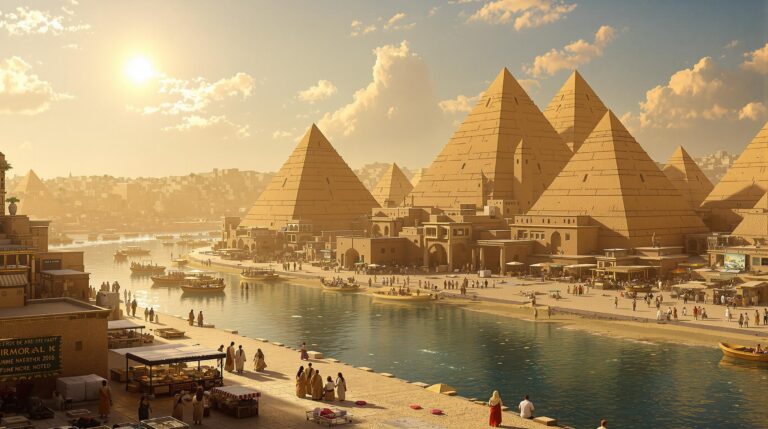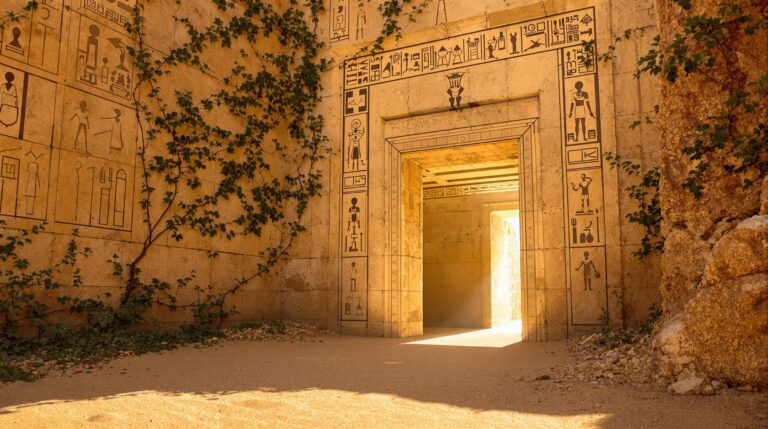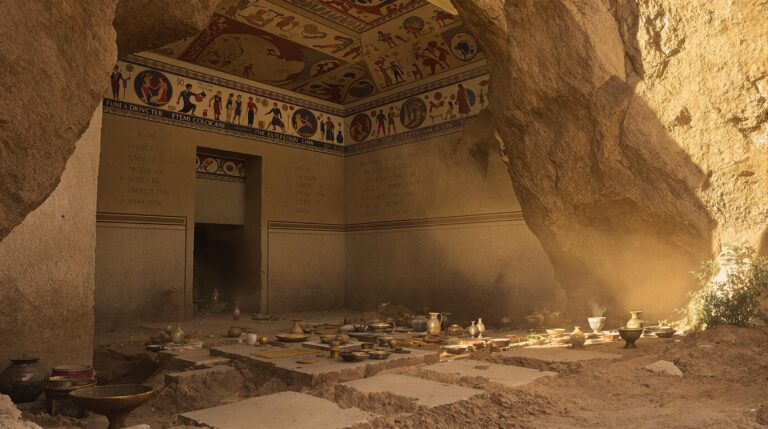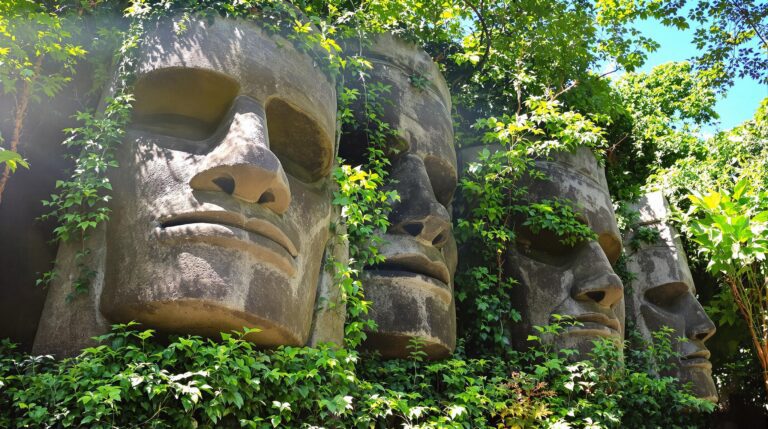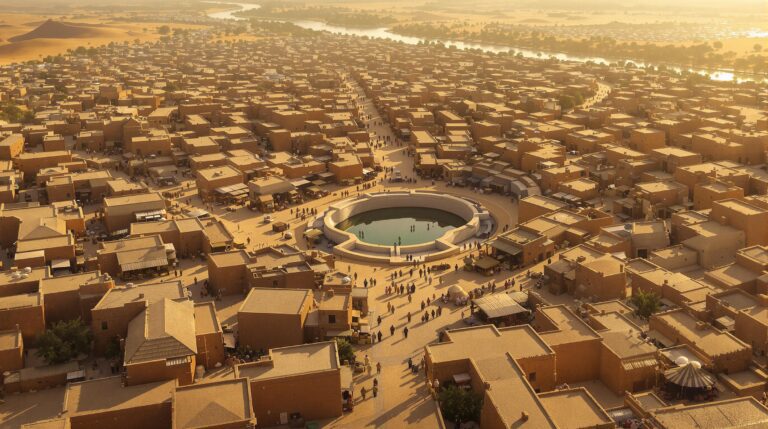The Hittite Empire: From Hattusa to History
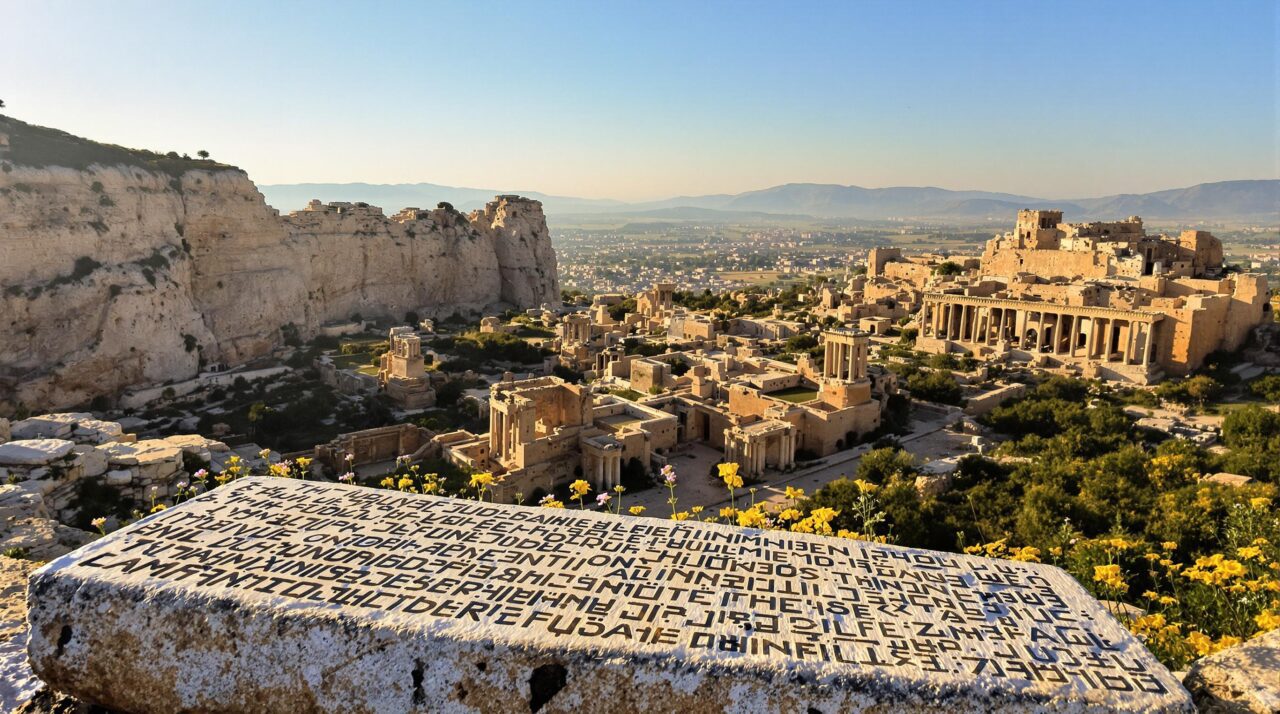
The Hittite Empire represents a pivotal chapter in ancient history, marked by its strategic location and military prowess.
Hattusa, its capital, served as a nexus of culture and governance.
As the empire expanded, it engaged in complex trade and diplomacy, influencing its neighbors considerably.
Yet, the factors leading to its decline remain enigmatic. What lessons can be drawn from its rise and fall, and how do they resonate with today’s geopolitical landscapes?
Principal Conclusions
Hide- Hattusa served as the political and cultural center of the Hittite Empire, facilitating trade and military expansion in Anatolia and beyond.
- Key rulers, including Labarna I and Suppiluliuma I, significantly expanded Hittite territory through military conquests and diplomatic relations.
- The Hittite legal framework established social order and governance, reflecting the values and hierarchy within their diverse society.
- Cuneiform and hieroglyphic writing fostered a rich literary tradition, documenting mythology, history, and legal matters that influenced future civilizations.
- The empire's decline resulted from invasions and internal strife, leading to the emergence of Neo-Hittite states and continued cultural evolution.
The Origins of the Hittite Civilization
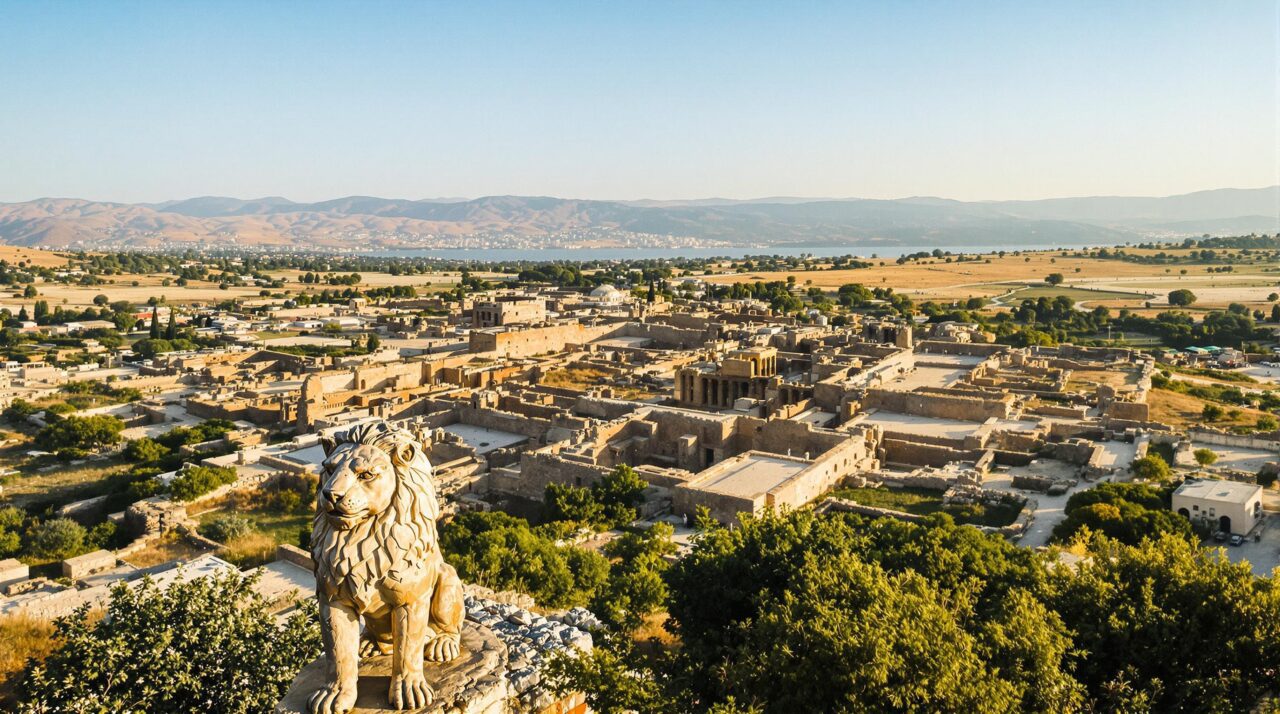
The origins of the Hittite civilization can be traced to early settlements that reflected a complex tapestry of cultural influences from neighboring regions.
As these communities evolved, the strategic rise of Hattusa emerged as a vital political center, shaping the trajectory of Hittite power and identity.
Understanding this formative period is essential to grasping the broader implications of Hittite interactions within the ancient Near East.
Early Settlements and Cultural Influences
The early settlements of the Hittite civilization reveal a complex interplay of indigenous Anatolian roots and the influx of Indo-European language, shaping their unique cultural identity.
Additionally, interactions with Mesopotamian and Assyrian traders facilitated the exchange of ideas, technologies, and goods, enriching Hittite society.
- Harappan Civilization: Inside the Planned Cities of the Indus Valley
- Ancient Nubia: The Forgotten Kingdom
- Babylon: Ancient City of Power and Mystery
- Göbekli Tepe Mystery: Ancient Site Redefines History
- Ancient Persia: Golden Age and the Achaemenid Legacy
- Etruscan Civilization: Secrets of the Etruscans Uncovered
Such influences not only laid the foundation for their political and military prowess but also contributed to the broader tapestry of ancient Near Eastern history.
Indigenous Anatolian Roots and Indo-European Language
While examining the origins of the Hittite civilization, one cannot overlook the intricate tapestry of indigenous Anatolian roots intertwined with the emergence of Indo-European language.
Key factors include:
- The convergence of native cultures fostering unique linguistic developments.
- The influence of migration patterns shaping the Hittite identity.
- The synthesis of agricultural practices that informed social structures.
Together, these elements laid the foundation for Hittite civilization.
Contacts with Mesopotamian and Assyrian Traders
Although often overshadowed by the grandeur of their own civilization, the Hittites engaged in significant interactions with Mesopotamian and Assyrian traders that played an essential role in shaping their early settlements and cultural identity.
These exchanges facilitated the flow of goods, ideas, and technologies, enriching Hittite society and contributing to a dynamic synthesis of cultural influences that would define their historical legacy.
The Rise of Hattusa as a Political Center
The geographic positioning of Central Anatolia played a pivotal role in the emergence of Hattusa as a political center within the early Hittite Kingdom.
Its strategic location facilitated trade and communication, fostering economic and cultural exchanges that were instrumental in the kingdom’s formation.
As Hattusa evolved, it became not only a hub of governance but also a symbol of the Hittite civilization‘s burgeoning identity and influence.
Geographic Importance of Central Anatolia
Central Anatolia’s strategic location played an essential role in the emergence of the Hittite civilization, as it served as a crossroads for trade and cultural exchange among neighboring regions.
Key factors contributing to its importance included:
- Access to essential trade routes connecting major civilizations.
- Fertile land supporting agricultural development.
- Proximity to natural resources, fostering economic growth.
These elements collectively facilitated Hattusa’s rise as a political center.
Formation of the Hittite Kingdom
Hattusa emerged as a significant political center within the Hittite Kingdom, shaped by a confluence of geographical advantages and socio-political dynamics.
Its strategic location facilitated trade and military endeavors, while the unification of various tribes under a centralized authority fostered stability.
This combination of factors propelled Hattusa to prominence, ultimately laying the foundational stones of a powerful and influential empire.
Expansion into Empire
The expansion of the Hittite Empire was marked by the strategic leadership of key kings who orchestrated significant military campaigns, expanding their territory and influence.
Additionally, their adept diplomatic relations with neighboring powerful states played a vital role in establishing Hittite dominance in the region.
This complex interplay of military might and diplomatic acumen raises questions about the sustainability of their imperial ambitions and the challenges they faced.
Key Kings and Military Campaigns
The Hittite Empire’s expansion was greatly influenced by pivotal rulers, particularly Labarna I, who spearheaded the unification of Anatolia, setting the stage for future conquests.
Following this foundational period, Suppiluliuma I emerged as a formidable figure, orchestrating military campaigns that extended Hittite influence into Syria and beyond.
These key kings not only shaped the political landscape but also laid the groundwork for an empire that would dominate the region for centuries.
Labarna I and the Unification of Anatolia
During the pivotal reign of Labarna I, a significant transformation unfolded across Anatolia as he laid the groundwork for the Hittite Empire’s expansion.
His strategic initiatives included:
- Centralizing authority to unify disparate city-states.
- Implementing military reforms that enhanced combat effectiveness.
- Establishing diplomatic ties with neighboring regions to foster stability.
These measures catalyzed the emergence of a cohesive and formidable Hittite identity, setting the stage for future conquests.
Suppiluliuma I’s Expansion into Syria and Beyond
Suppiluliuma I’s reign marked a transformative era in Hittite history, characterized by aggressive military campaigns that expanded the empire’s reach into Syria and beyond.
Through strategic alliances and decisive battles, he asserted Hittite dominance over rival states. This expansion not only secured valuable resources but also facilitated cultural exchanges, shaping a legacy that would influence the political landscape of the ancient Near East.
Diplomatic Relations with Powerful Neighbors
The Hittite Empire’s expansion was not solely achieved through military might; diplomatic relations played a vital role in shaping its interactions with powerful neighbors like Egypt, Babylonia, and Mitanni.
Key treaties, including those following the Battle of Kadesh, illustrate how strategic alliances and peace accords were instrumental in stabilizing borders and promoting trade.
This nuanced approach to diplomacy highlights the Hittites’ understanding of the importance of collaboration in maintaining and expanding their influence in the ancient Near East.
Treaties with Egypt, Babylonia, and Mitanni
As the Hittite Empire expanded its influence in the Late Bronze Age, its diplomatic engagements with neighboring powers such as Egypt, Babylonia, and Mitanni became essential for maintaining stability and promoting mutual interests.
Key treaties emphasized:
- Territorial integrity and recognition.
- Trade agreements facilitating economic cooperation.
- Military alliances to counteract common threats.
These accords were foundational in shaping the dynamics of power in the region.
The Battle of Kadesh and the First Peace Accord
Amidst the tumultuous landscape of the Late Bronze Age, the Battle of Kadesh emerged as a pivotal moment in Hittite history, encapsulating the complexities of military engagement and diplomatic maneuvering.
This clash between the Hittites and Egyptians not only showcased military prowess but also led to the first recorded peace accord, marking a significant shift towards diplomatic relations and the stabilization of regional power dynamics.
Government, Society, and Law
The Hittite Empire’s government was characterized by a centralized royal authority that wielded significant power over its administrative structure.
This system not only facilitated efficient governance but also laid the groundwork for a complex legal framework that governed social order.
An examination of these elements reveals how the Hittites navigated the challenges of empire-building while maintaining societal cohesion.
Royal Authority and Administrative Structure
The Hittite Empire’s royal authority was intricately linked to the king’s dual role as both chief priest and military leader, underscoring the intertwining of religion and governance.
This centralized power was further supported by a complex bureaucracy, where regional governors played essential roles in maintaining order and implementing the king’s decrees across vast territories.
Analyzing this structure reveals insights into how governance shaped Hittite society and law, reflecting broader themes of authority and control in ancient civilizations.
Role of the King as Chief Priest and Military Leader
In the Hittite Empire, the king embodied a unique duality as both chief priest and military leader, a fusion that underscored the intertwining of religion and governance.
This role was significant for several reasons:
- Legitimized authority through divine favor.
- Unified religious and military objectives.
- Fostered social cohesion and loyalty among subjects.
This duality reinforced the king’s central position in Hittite society.
Bureaucracy and Regional Governors
A complex bureaucracy characterized the Hittite Empire, essential for managing its vast territories and diverse populations.
Regional governors wielded significant authority, acting as intermediaries between the king and local communities. This structure facilitated efficient tax collection, law enforcement, and the implementation of royal decrees, ensuring stability.
Additionally, it allowed for adaptability, reflecting the empire’s commitment to maintaining order while accommodating regional autonomy.
Legal Codes and Social Order
The legal codes of the Hittite Empire reveal a complex social order that governed property, marriage, and labor, showcasing distinctive features that set them apart from contemporary Mesopotamian systems.
By analyzing these laws, one can uncover the underlying principles that shaped Hittite society and its values.
Such a comparison not only highlights the uniqueness of Hittite legal practices but also reflects broader trends in ancient Near Eastern governance.
Laws on Property, Marriage, and Labor
Although often overshadowed by their military conquests, the Hittite Empire’s legal framework governing property, marriage, and labor played an essential role in shaping its societal structure.
Key aspects included:
- Protection of land ownership rights, ensuring stability.
- Regulations on marriage, promoting familial alliances and inheritance.
- Labor laws, balancing employer-employee relationships and fostering economic growth.
These laws reflected a complex society prioritizing order and communal welfare.
Distinctive Features Compared to Mesopotamian Systems
Examining the legal and societal structures of the Hittite Empire reveals distinct differences from those of contemporary Mesopotamian systems.
The Hittites emphasized a more decentralized governance, allowing regional autonomy, contrasting with Mesopotamia’s centralized authority.
Additionally, Hittite laws displayed a pragmatic approach to justice, focusing on restitution rather than harsh penalties, fostering a social order that prioritized community harmony over rigid adherence to punitive measures.
Religion and Worldview
The Hittite Empire‘s religious framework was intricately woven around a pantheon dominated by storm gods and sun deities, reflecting the civilization’s deep connection to natural forces.
Sacred sites and religious architecture served not only as places of worship but also as symbols of power and community identity.
Understanding these elements reveals how the Hittites interpreted their world and sought to influence the divine through ritual and monumental expression.
Pantheon of Storm Gods and Sun Deities
The Hittite pantheon, dominated by storm gods and sun deities, underscores a complex religious framework that shaped both worship practices and societal norms.
Rituals conducted within grand temples not only served to appease these powerful deities but also reflected a syncretism that integrated local and foreign beliefs, revealing the Empire’s adaptive spirituality.
This interplay of divine reverence and cultural exchange invites a deeper examination of how religion influenced Hittite identity and governance.
Worship Practices and Temple Rituals
While the Hittite Empire is often remembered for its military prowess and diplomatic strategies, its intricate web of worship practices and temple rituals reveals a profound relationship between the people and their pantheon of deities, including storm gods and sun deities.
Key elements of their worship included:
- Elaborate offerings to appease the gods.
- Seasonal festivals celebrating agricultural cycles.
- Divination practices to seek divine guidance.
Syncretism with Local and Foreign Beliefs
As the Hittite Empire expanded its territories and engaged in diplomatic relations with neighboring cultures, the syncretism of local and foreign beliefs became a hallmark of its religious landscape.
This blending manifested in the incorporation of diverse storm gods and sun deities, reflecting a dynamic worldview that embraced multiplicity, allowing for a vibrant mosaic of spirituality that fostered both unity and individuality within the empire.
Sacred Sites and Religious Architecture
The Sanctuary at Yazılıkaya stands as a tribute to the Hittites’ intricate relationship with their deities, showcasing the profound significance of sacred sites in their religious practice.
The rock reliefs within this sanctuary not only depict divine figures but also serve as visual narratives that encapsulate the empire’s spiritual worldview.
The Sanctuary at Yazılıkaya
Nestled within the rugged landscape of central Anatolia, the Sanctuary at Yazılıkaya stands as a monumental tribute to Hittite religious practices and architectural ingenuity.
This sacred site features:
- Intricate rock carvings depicting deities and rituals.
- A ceremonial pathway enhancing the spiritual experience.
- Strategic orientation aligning with celestial phenomena.
These elements reflect the Hittites’ profound connection to the divine and their sophisticated understanding of the cosmos.
Symbolism in Rock Reliefs and Offerings
Rock reliefs and offerings at the Sanctuary at Yazılıkaya serve as profound expressions of Hittite spirituality and worldview.
These artistic representations encapsulate the divine narratives and cultural values of the Hittites, intertwining myth with daily life.
Each relief, meticulously carved, reflects a complex interplay between the sacred and the secular, inviting contemplation on the nature of existence and the human connection to the divine.
Writing, Language, and Literature
The Hittite Empire’s adoption of cuneiform and hieroglyphic scripts marked a significant evolution in their communication and cultural expression.
This integration facilitated the creation of a rich literary tradition, encompassing texts on mythology, history, and law, which not only documented their societal values but also provided insight into their worldview.
Adoption of Cuneiform and Hieroglyphic Scripts
The Hittite Empire‘s adoption of cuneiform and hieroglyphic scripts marked a significant evolution in their administrative practices and cultural exchanges.
Archives from Hattusa reveal a complex web of correspondence with foreign powers, highlighting the empire’s diplomatic and economic engagements.
Modern scholarship’s efforts to decipher these texts continue to illuminate the intricate tapestry of Hittite language, literature, and their historical context.
Archives from Hattusa and Correspondence with Foreign Powers
Although the Hittite Empire was known for its military prowess and territorial expansion, its intellectual legacy is equally significant, particularly in the domain of written communication.
The archives from Hattusa reveal:
- Diplomatic correspondences with neighboring kingdoms.
- Administrative documents that detail governance.
- Literary texts that reflect Hittite culture and beliefs.
These records illustrate the empire’s sophisticated engagement with the wider world.
Decipherment and Modern Scholarship
While the Hittite Empire flourished, its writing systems underwent significant adaptations that would shape its intellectual landscape.
The adoption of cuneiform and hieroglyphic scripts facilitated the exchange of ideas, blending indigenous traditions with external influences.
Modern scholarship reveals the complexities of these texts, offering insights into Hittite society, governance, and culture, thereby illuminating the empire’s enduring legacy and its contributions to the tapestry of human history.
Texts on Mythology, History, and Law
The Hittite Empire’s texts on mythology, history, and law reveal a vibrant mosaic of epic narratives and royal annals that not only chronicled their civilization but also influenced subsequent cultures.
These writings served as a means of consolidating power and shaping identity, reflecting the complexities of Hittite society.
The impact of these texts resonates through time, laying foundational elements for later civilizations in the region.
Epic Narratives and Royal Annals
Epic narratives and royal annals form an essential component of Hittite literature, reflecting the civilization’s values, beliefs, and historical consciousness.
These texts serve to:
- Chronicle significant events in Hittite history.
- Illustrate the divine right of kings and their relationship with deities.
- Preserve cultural myths that shape collective identity.
Through these narratives, the Hittites conveyed their worldview and aspirations.
Influence on Later Civilizations
Hittite literature, particularly through its epic narratives and royal annals, laid a foundation that influenced subsequent civilizations in profound ways.
Its exploration of mythological themes, legal frameworks, and historical accounts resonated with neighboring cultures. Scribes and scholars adopted Hittite linguistic structures, enriching their own writing.
The legacy of Hittite texts endures, shaping the literary and legal traditions of later societies.
Trade, Technology, and Innovation
The Hittite Empire‘s advancements in trade, technology, and innovation greatly shaped its societal structure and interactions with neighboring cultures.
Notable achievements in metalworking and chariot design showcased their engineering prowess, while agricultural practices and infrastructure development facilitated economic growth.
This interplay of innovation not only enhanced their military capabilities but also reinforced their position as a pivotal player in regional trade networks.
Metalworking and Chariot Design
The Hittite Empire’s advancements in metalworking, particularly the utilization of iron and bronze, greatly transformed their tools and weapons, enhancing both their military capabilities and everyday life.
This innovative approach not only reflected their technical prowess but also played an essential role in shaping military strategies and improving mobility on the battlefield.
Consequently, the evolution of chariot design, fueled by these materials, underscored the empire’s dominance and adaptability in a rapidly changing ancient world.
Use of Iron and Bronze in Tools and Weapons
Although the Hittites are often celebrated for their military prowess, it was their innovative use of iron and bronze in tools and weapons that greatly transformed their society and influenced surrounding regions.
Key advancements included:
- Enhanced durability of weapons, leading to superior combat effectiveness.
- Development of advanced agricultural tools, boosting productivity.
- Establishment of trade networks, facilitating the exchange of metal resources.
These innovations reshaped their economy and power dynamics.
Contributions to Military Strategy and Mobility
Utilizing the advancements in metalworking and chariot design, the Hittites revolutionized military strategy and mobility in the ancient world.
Their innovative chariots, equipped with reinforced wheels and lighter frames, enhanced speed and maneuverability on the battlefield.
This technological edge not only allowed for rapid troop movements but also facilitated effective communication and logistics, ultimately redefining the dynamics of warfare in their region.
Agriculture, Architecture, and Infrastructure
The Hittite Empire’s success in agriculture, architecture, and infrastructure reveals a sophisticated understanding of resource management and urban planning.
Storage facilities and irrigation systems enhanced agricultural productivity, while extensive road networks facilitated trade and communication across the empire.
Additionally, the construction of fortification walls underscored the Hittites’ commitment to security and strategic urban development.
Storage Facilities, Irrigation, and Road Networks
While the Hittite Empire is often celebrated for its military prowess and diplomatic innovations, its advancements in infrastructure—particularly storage facilities, irrigation systems, and road networks—played an essential role in fostering economic stability and facilitating trade.
Key components included:
- Granaries that guaranteed food security.
- Innovative irrigation methods enhancing agricultural output.
- Extensive road networks promoting efficient commerce and communication.
These innovations underpinned a thriving society.
Fortification Walls and Urban Planning
Hittite urban landscapes were marked by impressive fortification walls that not only served as protective barriers against invaders but also reflected the empire’s strategic emphasis on security and stability.
These walls delineated urban areas, fostering organized growth and controlled trade.
Collapse and Legacy
The collapse of the Hittite Empire presents a complex interplay of sociopolitical, economic, and environmental factors that led to its decline in the late Bronze Age.
This fall not only reshaped the geopolitical landscape of the ancient Near East but also prompted a resurgence of interest in Hittite civilization through archaeological rediscovery.
The legacy of the Hittites continues to inform contemporary understanding of ancient empires and their enduring influences on subsequent cultures.
The Fall of the Hittite Empire
The fall of the Hittite Empire represents a complex interplay of external invasions, internal strife, and the broader phenomenon of the Bronze Age Collapse.
As central authority waned, fragmented power structures emerged, giving rise to the Neo-Hittite states that would carry fragments of Hittite culture into a new era.
Analyzing this shift reveals not only the vulnerabilities that led to the empire’s decline but also the enduring legacy that shaped subsequent civilizations in the region.
Invasions, Internal Conflict, and the Bronze Age Collapse
As the Bronze Age drew to a close, a convergence of invasions and internal strife greatly weakened one of the ancient world’s most formidable powers.
Key factors contributing to the Hittite Empire’s decline included:
- The relentless incursions of the Sea Peoples.
- Escalating civil unrest and power struggles within Hittite society.
- Economic turmoil exacerbating resource scarcity.
These dynamics culminated in a profound collapse, echoing through history.
Disappearance of Central Power and Rise of Neo-Hittite States
With the disintegration of central authority following the Hittite Empire’s collapse, a remarkable transformation occurred in the region.
Local chieftains and former vassals seized the opportunity to establish Neo-Hittite states, fostering a mosaic of cultures and identities.
This decentralization encouraged autonomy, allowing diverse political entities to flourish, yet also led to fragmentation, signaling a complex legacy of resilience amid the ruins of a once-great empire.
Rediscovery Through Archaeology
The excavation of Hattusa and various other sites has greatly enriched the understanding of the Hittite Empire and its intricate connections to the broader history of Anatolia.
These archaeological efforts have unearthed artifacts and structures that challenge preconceived notions about the region’s past, revealing a complex society marked by cultural interactions and innovations.
As scholars analyze these findings, the legacy of the Hittites continues to take shape, informing both historical narratives and contemporary perspectives on ancient civilizations.
Excavations at Hattusa and Other Sites
Although the collapse of the Hittite Empire in the late Bronze Age marked a significant turning point in ancient history, the subsequent rediscovery of its capital, Hattusa, and other archaeological sites has revealed a lively mosaic of cultural and political complexity.
Key findings include:
- Extensive urban planning
- Multilingual inscriptions
- Evidence of international trade relations
These discoveries reshape perceptions of Hittite civilization’s sophistication.
Impact on Modern Understanding of Anatolia’s Past
As scholars investigate the remnants of the Hittite Empire, they uncover layers of history that not only illuminate the complexities of Hittite society but also reshape modern understanding of Anatolia’s past.
This archaeological renaissance reveals connections between cultures, trade networks, and political dynamics, challenging preconceived narratives.
Such discoveries encourage a reevaluation of historical continuity, enriching the tapestry of Anatolia’s ancient civilizations.
Wrapping Up
The Hittite Empire, despite its eventual decline, serves as a demonstration of the resilience and adaptability of ancient civilizations.
While some may argue that its fall overshadows its achievements, the Hittites’ contributions to governance, law, and cultural exchange continue to resonate through history.
Their legacy, manifested in the Neo-Hittite states, illustrates how even in decline, a civilization can influence future societies. Consequently, the story of the Hittites remains an essential chapter in the tapestry of human history.
